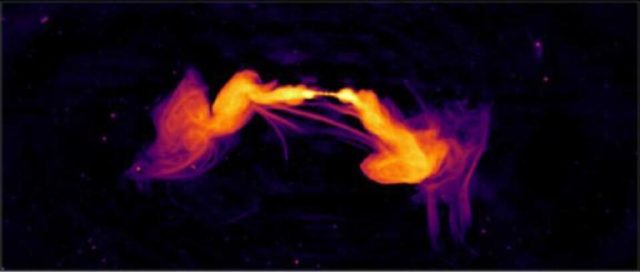An international team of astronomers has uncovered unusual features in the radio galaxy ESO 137-006 using MeerKAT data.
An international team of astronomers has uncovered unusual features in the radio galaxy ESO 137-006 using MeerKAT data.
Launched in 2018, the South African MeerKAT radio telescope in the Northern Cape is a precursor to the Square Kilometre Array (SKA), which aims to answer fundamental astrophysical questions about the nature of objects in the universe.
According to a press statement issued on Wednesday by SARAO (South African Radio Astronomy Observatory), ESO 137-006 is a fascinating galaxy residing in the Norma cluster of galaxies, and is one of the brightest objects in the southern sky at radio wavelengths.
The classical picture of a radio galaxy consists of an active galactic nucleus (AGN, hosting a growing supermassive black hole), shooting out two jets of plasma filled with particles that move at speeds close to the speed of light. The material within the jets eventually slows down and billows out, forming large radio lobes. ESO 137-006 is characterised by two such lobes of very bright radio emission.
“New features have been uncovered in this galaxy in the form of multiple, extremely collimated threads of radio emission connecting the lobes of the galaxy. The radio emission from the threads is likely synchrotron radiation caused by the high-energy electrons spiralling in a magnetic field,” Mpati Ramatsoku, a Research Fellow at Rhodes University and lead author of the study, said.
According to Ramatsoku, the nature of these unusual features is unclear. “It is possible that these features may be unique to ESO 137-006, because of its harsh environment, but it is equally possible that these features are common in radio galaxies but, so far, we have been unable to detect them due to sensitivity and resolution limits.”
According to the team that made this discovery, which is composed of collaborators from South Africa and Italy and is partly funded by the European Research Council, further observations and theoretical efforts are required to clarify the nature of these newly discovered features.
Ramatsoku points out that understanding the nature and the physics of these collimated synchrotron threads (CST) could open a new science case for sensitive radio interferometers like MeerKAT and, in the future, the SKA.
“This is exciting because we did not expect it at all,” Professor Oleg Smirnov, Head of the Radio Astronomy Research Group at SARAO, said. “Such serendipitous discoveries are very important for MeerKAT because it highlights its incredible capacity for finding the ‘unknown unknowns’ in our Universe,” he stated.








